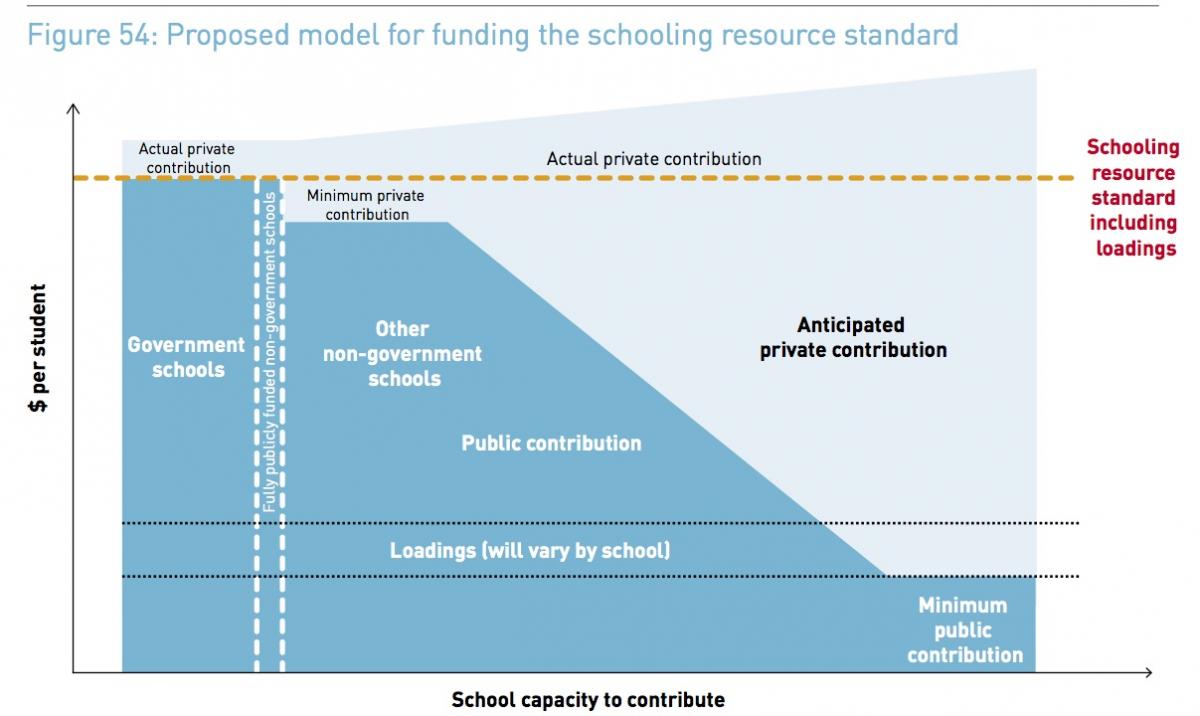On Sunday Prime Minister Julia Gillard announced the proposed Gonski funding reforms. Overall, funding will increase by $14.5 billion. That’s $4000 per student. Public schools will receive an extra $12 billion, Catholic schools will get an extra $1.5 billion and independent schools an extra $1 billion. Sixty-five per cent will be funded by the Federal government.
It’s an important and thoughtful piece of policy. The new schooling resource standard (SRS) will give schools the same base amount per child, around $10,500 for secondary and $8000 for primary students. On top of the SRS, extra money will be provided for children with disadvantages (disabilities, English language learners, etc.).
The new SRS model is simpler than the current funding model. All schools—government, independent and Catholic—will be funded using the same base model.
Under the new model, government schools will get 100 per cent of the SRS via a combination of state and federal funds. In the wealthiest private schools, about 80 per cent of the SRS will be funded by parents. As a school’s estimated parent contribution decreases, the government contribution increases. A small Catholic school in the bush could receive over 90 per cent of its funding from the government.

The government has simplified a funding formula — less paperwork with a similar bottom-line — so why the fuss? First, some people in state governments are wary of federal intrusion. Traditionally, the states fund government schools while the federal government provides support for private schools. The new SRS rolls federal, state and parent contributions into one amount.
Before worrying about the details of funding formulas, let's step back and ask a bigger question: Should the government — federal, state or otherwise — be funding private schools at all?
While balancing on the federal-state tightrope, the Gonski review has sidestepped this question. But the press deluge has re-kindled the “public-funding-of-private-schools” debate.
Public school supporters fear increased government funding of private schools will lead to middle-class flight. Last week, The Australian ran an article revealing that public schools have increased their proportion of less-well-off students (note: “poor” is defined as less than $1249 per week) Advocates of non-government schools, particularly Catholic schools, think federal funding is crucial for effective schooling.
Using the 2011 figures in the Gonski report, parent contributions are 54 per cent for independent, 24 per cent for Catholic and four per cent for government schools. You can look up the funding percentages of schools in your neighbourhood on the MySchool website.
So those are the figures. Let's briefly look at some of the arguments:
Governments should fund non-government schools
Struggling middle-class parents won’t be able to afford tuition if government support disappears. Shadow Education Minister Christopher Pyne argues that the new budget could be as much as $1.3 billion short, and that this difference will result in higher parent fees. This would particularly impact middle-class parents.
Private schools save the public system money. Scott Prasser estimates private schools save the public purse $8 billion. He sees thinks public schools should pursue more private donations and worries about the lack of firm policy support for non-government schooling.
Private schools are underfunded for students with disabilities. Currently, non-government schools receive less money for students with disabilities. The Executive Director of the Independent Schools Council of Australia, Bill Daniels, believes it will be even harder to support disadvantaged students under the Gonski report's proposal to cancel targeted program funding.
Governments shouldn't fund non-government schools
Rich families don’t need subsidies for their private choices. “We don't expect subsidies for business class or motorway tolls, why should a struggling worker on an average wage of $50,000 be asked to contribute to the education of the [rich]?” writes David Zyngier, a former school principal and senior lecturer at Monash University.
Some private schools get too much government money. Australian Educators Union Federal president Angelo Gavrielatos argues that MySchool data shows that some wealthy schools are receiving more government money per child than state schools. “How is it that we have reached the point where private schools serving wealthier families receive thousands more in government funding per student than public schools serving low-income communities?” The Greens party also worries that private schools are benefitting unfairly.
Resources should go towards keeping middle-class kids in public schools. Professor Richard Teese at the University of Melbourne believes that middle-class flight will create sinks of disadvantage.
To complicate matters further, school funding is not a black-and-white, government-or-private issue. Shades of gray—like tax benefits and school vouchers—exist. One things is clear: the current system is confusing and inefficient. In its response to the Gonski report, the government said this is a once-in-a-generation opportunity to reform school funding.
Commonwealth funding would increase by 4.7 per cent, provided the states and territories boost their spending by 3 per cent. The Federal Government has given the States until 30 June to sign up for the Gonski plan. Tasmania, South Australia and the ACT have agreed to endorse this plan.
States and territories have two months to decide their funding future. Some states, like Queensland, are not sure if they can spare the funding to participate. Others are waiting for more detail on Friday’s COAG meeting.
Watch this space closely: Friday’s meeting, and every decision made between now and the end of June will contain critical funding decisions that will affect the next generation of schoolchildren.
Donate To New Matilda
New Matilda is a small, independent media outlet. We survive through reader contributions, and never losing a lawsuit. If you got something from this article, giving something back helps us to continue speaking truth to power. Every little bit counts.



